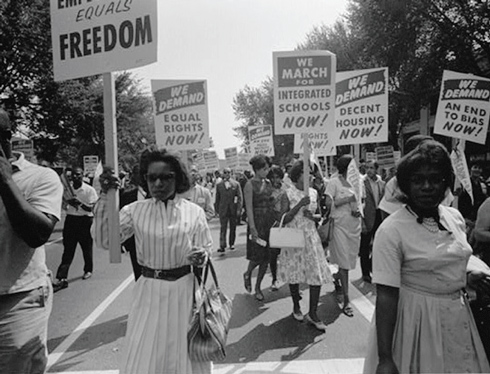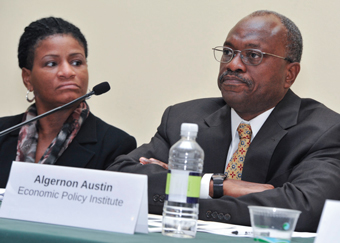The 'forgotten goals' of the 1963 March on Washington
By Freddie Allen NNPA Washington Correspondent | Last updated: Jul 2, 2013 - 3:08:42 PMWhat's your opinion on this article?

WASHINGTON (NNPA) - The hoopla surrounding the observance of the 50th anniversary of the March on Washington for Jobs and Freedom often ignores a lack of progress made since 1963 on tough issues such as persistent unemployment and wage disparities, according to a newly-issued report.
In the report titled “The Unfinished March: An Overview,” Algernon Austin, director of the Program on Race, Ethnicity and the Economy at the Economic Policy Institute, described the “forgotten history of the march” and outlined a number of goals that remain unmet.
“Our contemporary understanding of the march and of the civil rights movement, more generally, is quite limited,” said Mr. Austin, the author of the report. He said Blacks often celebrate the accomplishments of the march, such as the Civil Rights Act of 1964 and the Voting Rights Act of 1965, but ignore intransigent economic issues, including housing, employment, and wage disparities, that were raised by the national demonstration.
“Historians have focused on the successes and they were tremendous successes when you consider how long and how deep Jim Crow was in American society,” explained Mr. Austin. “There were significant advances that deserved to be celebrated, but we probably celebrated those advances a little too much.”

The EPI report said: “The organizers of the March on Washington for Jobs and Freedom also demanded decent housing, adequate and integrated education, a federal jobs program for full employment, and a national minimum wage of over $13.00 an hour in today’s dollars.”
James Clingman, author of “Blackonomics,” a weekly NNPA syndicated column, said that Dr. Martin Luther King, Jr., despite history’s focus on his civil rights success, also recognized the economic crisis that the Black community faced and often advocated for Black workers.
Many of the civil rights leaders and the organizers of the march understood that gaining civil rights without addressing economic disparities would leave Blacks unable to fully enjoy those rights.
“We have no future in a society in which 6 million Black and White people are unemployed and millions more live in poverty. Nor is the goal of our civil rights revolution merely the passage of civil rights legislation,” said A. Philip Randolph, president of the Negro American Labor Council, during his speech at the march in 1963.
“Yes, we want all public accommodations open to all citizens, but those accommodations will mean little to those who cannot afford to use them.”
By the end of the 1960s, the Black poverty rate was 32.2 percent. Since then, improvements in the poverty rate have slowed to a crawl, reaching its lowest mark in 2001 at 22.5 percent. According to the EPI study, economic turmoil created by the housing crisis and the Great Recession pushed the rate up 27.6 percent in 2011, nearly triple the White poverty rate recorded that same year.
Poor Blacks often live in highly segregated neighborhoods and suffer higher exposure to environmental hazards, including lead. Black children suffer the highest exposure rates, even though lead exposure has declined for other racial groups.
“Today, nearly half of poor black children live in neighborhoods with concentrated poverty; however, only a little more than a tenth of poor White children live in similar neighborhoods,” stated the report.
Mr. Austin said poverty and housing issues also affect educational outcomes for children, making it difficult to address one issue effectively while ignoring others.
According to the report, in 2010, 74.1 percent of Black children attended predominantly Black schools.
“Part of the reason that our schools are so segregated is because our neighborhoods are also segregated,” said Mr. Austin. “The issue of segregated and unequal schools is also wrapped up in the issue of segregated and unequal housing.”
When minority student enrollment tops 90 percent at a school, the school budget takes a $443,000 hit, compared to schools where the enrollment is 90 percent or more White, according to the report. That money could go to hiring more teachers, counselors and resource staff or buying laptop computers.
Black high school students have the lowest graduation rate among racial groups at 66.1 percent. Eighty-three percent of White high school students earn diplomas.
Mr. Austin said that poverty, segregated housing, and disadvantaged unequal education all place limits on employment and wages.
The unemployment rate for Blacks has been nearly double the rate for Whites over the past 50 years.
“In 2012, the Black unemployment rate was 14.0 percent, 2.1 times the White unemployment rate (6.6 percent) and higher than the average national unemployment rate of 13.1 percent during the Great Depression, from 1929 to 1939,” stated the report.
Mr. Austin said that even if the goal of full employment for Black workers is achieved, it would mean little if Blacks continued to earn poverty-level wages.
The report found that 36 percent of Blacks working full-time didn’t earn enough to lift their families out of poverty.
Researchers found that 19.1 percent of low-wage Black workers in Chicago, Los Angeles and New York City were paid below the legal minimum wage and 63.9 percent were underpaid for overtime work.
“Thus, some of the lowest-paid Black workers are having their earnings effectively stolen by employers,” said the report.
Mr. Austin said pressing economic concerns that Black leaders identified 50 years ago, still don’t receive enough attention.
“This anniversary people should really take time to look deeply at the march, we hear King’s speech every year probably once or twice a year, but there were nine other speeches and there were seven demands,” said Mr. Austin. “We should take some time to dig a little deeper into that history and use that history to inspire us to act together.”
Mr. Austin added: “Important social change requires a mass mobilization. The Tea Party movement has managed to elect members of Congress and shape the views of some members of Congress. As a result, that movement has significant impact on our politics today.” Mr. Clingman said that accomplishing significant economic progress in the Black community will take a movement in which Black people are willing to make individual sacrifices to achieve economic goals.
“Our economic goals are not going to come to fruition through politics alone,” said Mr. Clingman. “We’re going to have to have strong, committed, purposeful, intentional movements in order to achieve not only the goals that we have, but some of the same goals that Martin Luther King Jr., worked for before he was killed.”
INSIDE STORIES AND REVIEWS
-
-
About Harriett ... and the Negro Hollywood Road Show
By Rabiah Muhammad, Guest Columnist » Full Story -
Skepticism greets Jay-Z, NFL talk of inspiring change
By Bryan 18X Crawford and Richard B. Muhammad The Final Call Newspaper @TheFinalCall » Full Story -
The painful problem of Black girls and suicide
By Charlene Muhammad -National Correspondent- » Full Story -
Exploitation of Innocence - Report: Perceptions, policies hurting Black girls
By Charlene Muhammad -National Correspondent- » Full Story -
Big Ballin: Big ideas fuel a father’s Big Baller Brand and brash business sense
By Bryan Crawford -Contributing Writer- » Full Story






 Click Here Stay Connected!
Click Here Stay Connected!








